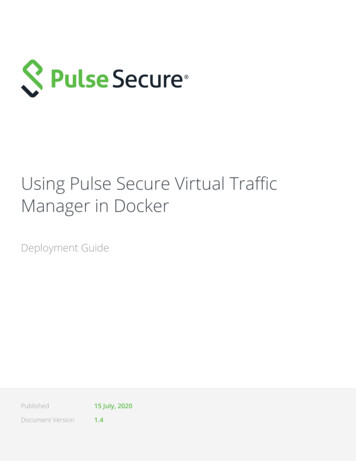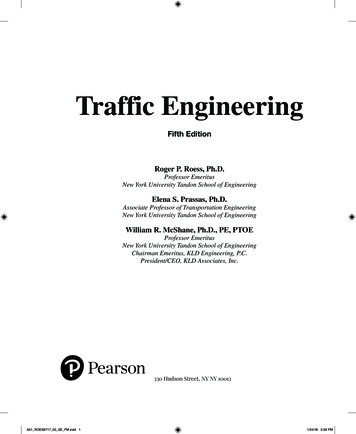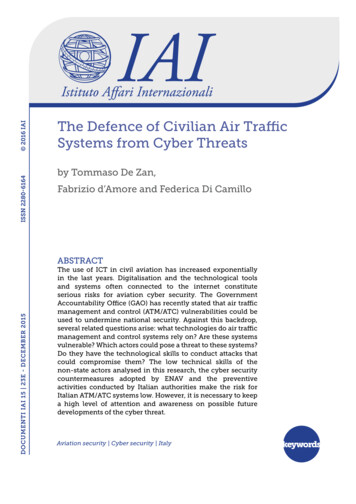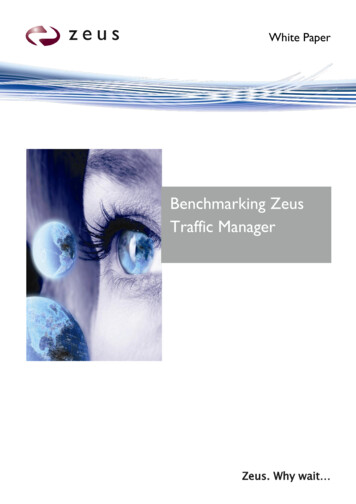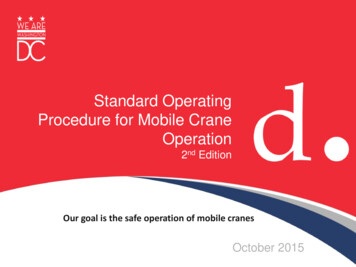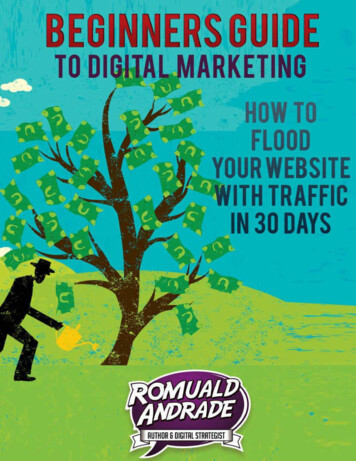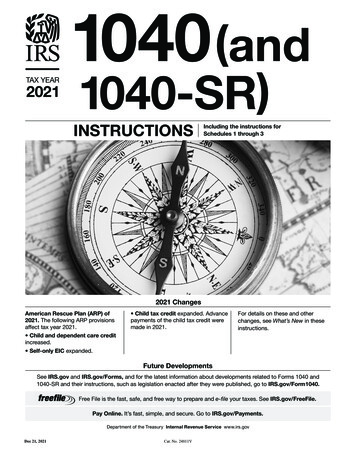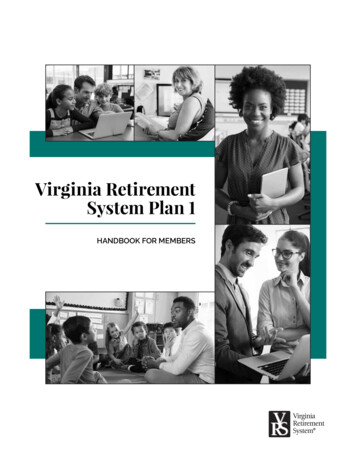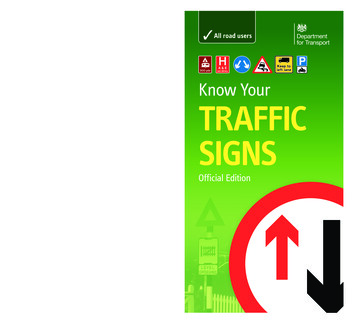
Transcription
DfTKnow YourHow well do you know yourtraffic signs?This book is a fully updated edition of the highlysuccessful Know Your Traffic Signs first published byHMSO in 1975. It contains information about the mostimportant traffic signs, including many introduced sincethe 1995 edition. The aim is to illustrate and explain thevast majority of traffic signs the road user is likelyto encounter.Know Your TRAFFIC SIGNSTraffic signs play a vital role in directing, informing andcontrolling road users’ behaviour in an effort to make theroads as safe as possible for everyone. A knowledge oftraffic signs is therefore essential, not just for new driversor riders needing to pass their theory test, but for allroad users, including experienced professional drivers.All road usersTRAFFICSIGNSOfficial EditionKnow Your Traffic Signs for life, not just for learners 4.99www.tso.co.uk9780115528552 010 KYTS COVER v2 0.indd 1-3ISBN 978-0-11-552855-29 780115 52855224/08/2015 12:15
Know YourTRAFFICSIGNSOfficial EditionLondon: TSO780115528552 011 KYTS TEXT v2 0.indd 121/08/2015 15:38
Department for TransportGreat Minster House33 Horseferry RoadLondon SW1P 4DRTelephone 0300 330 3000Website www.gov.uk/dftwww.gov.uk/traffic-signs Crown copyright 2007, except where otherwise statedCopyright in the typographical arrangement rests with the Crown.You may re-use this information (not including logos or third-party material)free of charge in any format or medium, under the terms of the OpenGovernment Licence v2.0. To view this licence, nt-licence/version/3or write to the Information Policy Team, The National Archives, Kew,London TW9 4DU, or e-mail: psi@nationalarchives.gsi.gov.ukArtwork of traffic signs should be reproduced accurately and not in amisleading context, for example not on roadside billboards.ISBN 978 0 11 552855 2First published 1975Fifth edition 2007Seventeenth impression 2015Available from www.tsoshop.co.uk780115528552 011 KYTS TEXT v2 0.indd 2Printed in Great Britain on paper containing atleast 75% recycled fibre.221/08/2015 15:38
ContentsPageIntroduction4The signing system9Warning signs10Regulatory signs16Speed limit signs20Low bridge signs22Level crossing signs and signals26Tram signs, signals and road markings30Bus and cycle signs and road markings32Pedestrian zone signs37On-street parking control signs and road markings39Road markings62Traffic calming72Motorway signs, signals and road markings77Direction signs on all-purpose roads94Direction signs for cyclists and pedestrians112Information signs114Traffic signals119Tidal flow lane control signs and signals121Pedestrian, cycle and equestrian crossings122Signs for road works and temporary situations128Miscellaneous signs140
IntroductionWhy know your traffic signs?Traffic signs play a vital role in directing, informing and controllingroad users' behaviour in an effort to make the roads as safe aspossible for everyone. This makes a knowledge of traffic signsessential. Not just for new drivers or riders needing to pass theirtheory test, but for all road users, including experiencedprofessional drivers.Keeping up to dateWe live in times of change. Society, technology and the economy allplay their part in changing the way we travel. New road signsconveying new messages and in new formats are introduced fromtime to time, so drivers or riders who passed their driving test a fewyears ago need to keep up to date or run the risk of failing tounderstand or comply with recently introduced signs.Do youunderstandthe colourcoding onsigns suchas this?A few examples of events that called for new signs include: Britain's first motorway Pelican crossings Reintroduction of trams Advanced stop lines Vehicle-activated signs Active Traffic Management.
introductionHaving experience is all very well, but it's not enough if yourknowledge is out of date.Responsibility for traffic signsResponsibility for the road network in the UK is split among: the Highways Agency in England the Welsh Assembly Government in Wales the Scottish Executive in Scotland and local or regional highway authorities.The central administrations above are responsible for the UK’sstrategic road network. Strategic roads are the highways that linkcities, areas of population, ports and airports. Most motorways andsome “A” roads are strategic roads.Local or regional highway authorities are responsible for localroads, and this includes a few motorways, all other “A” roads andall other public roads. While responsibility for placing, erecting andmaintaining traffic signs is split among these bodies, it is importantthat signs are consistent both in appearance and in the way theyare used.To ensure that the UK has a uniform traffic signing system, signsmust conform to the designs prescribed in the Traffic SignsRegulations and General Directions (although some signs mayhave been specially authorised by the Secretary of State).The Traffic Signs Manual, published by TSO, provides detailedguidance for those responsible for designing and installingtraffic signs.For more information about traffic signs guidance, seewww.dft.gov.uk/pgr/roads/tss
A brief history of traffic signsIt was probably the Romans who first used "traffic signs" in Britain.They marked off road distances at one thousand paces (about onemile) with stones called "milliaries".Most early signposts were erectedby private individuals at their ownexpense. A law passed in 1648required each parish to place guideposts at its crossroads, but it wasnot until after the General TurnpikeAct 1773 that these "guide posts" or"fingerposts" became more common.During the second half of thenineteenth century, bicycles becamemore popular. Steep hills and sharpbends were very dangerous for earlycyclists, and "danger" and "caution"signs were erected at the top ofsteep hills. Signs showing skull andcrossbones were erected at themost dangerous places. Local authorities and cycling organisationsinstalled an estimated 4000 warning signs.The year 1896 heralded the era of themotor car, and some motoringassociations took up the business ofplacing signs. The Motor Car Act 1903made local authorities responsible forplacing certain warning and prohibitorysigns. The signs were for crossroads,steep hills and dangerous bends. "A" and "B" numbering of roadswas introduced in 1921, and these numbers were shown onfingerpost-style signs alongside the destination and distance. Townor village name signs and warning signs for schools, level crossingsand double bends were introduced at the same time.
introductionThe main task of signposting our roads during the 1920s and1930s still fell on the motoring organisations, but in in 1931 acommittee chaired by Sir Henry Maybury was asked torecommend improvements to the signing then in use, and by 1933further new signs began to appear, including "No entry" and "Keepleft" signs, warning signs for narrow roads and bridges, lowbridges, roundabouts and hospitals. Other signs followed duringthe 1930s, including "Halt at major road ahead". These formed thebasis of our traffic signing until the early 1960s.It was not until after 1918 thatwhite lines began to appear onBritish roads, and during the1920s their use spread rapidly.In 1926 the first Ministry ofTransport circular on the subjectlaid down general principles onthe use of white lines. In the1930s, white lines were used as"stop" lines at road junctions controlled by either police or trafficlights. Reflecting road studs (often referred to as "cat's eyes") firstcame into use in 1934. By 1944, white lines were also being usedto indicate traffic lanes and define the boundary of the maincarriageway at entrances to side roads and lay-bys, and inconjunction with "halt" signs. In 1959, regulations came into effectto control overtaking by the use of double white lines.
It was realised that the old system ofsigning would not be adequate formotorways, and the AndersonCommittee was set up in 1958 toconsider new designs. It recommendedmuch larger signs, with bluebackgrounds. Then, in 1961, theWorboys Committee began to reviewthe complete system of traffic signing. Itconcluded that the UK should adoptthe main principles of the Europeansystem, with the message expressed as a symbol within a redtriangle (for warning signs) or a red circle (for prohibitions). Workbegan on the conversion of British signs in 1965, and this is still thebasic system in use today.Later developmentsinclude the use of yellowbox markings at busyroad junctions, specialsigns and road markingsat pedestrian crossings,mini roundabouts andbus lanes. Regulationspublished in 1994included new regulatory and warning signs and simplified the yellowline system of waiting restrictions that was originally introduced inthe 1950s. Further Regulations were published in 2002.More use is being made ofnew technology to providebetter information to driverson hazards, delays anddiversions. The future willundoubtedly see moredevelopments in trafficsigning to keep pace with thechanging traffic demands onour roads.
the signing systemThe signing systemThere are three basic types of traffic sign: signs that give orders,signs that warn and signs that give information. Each type has adifferent shape. A further guide to the function of a sign is itscolour. All triangular signs are red.Circlesgive ordersTriangleswarnRectanglesinformBlue circles generally give a mandatory instruction,such as "turn left", or indicate a route available only toparticular classes of traffic, e.g. buses and cycles onlyRed rings or circles tell you what you must not do,e.g. you must not exceed 30 mph, no vehiclesover the height shown may proceedBlue rectangles areused for informationsigns except onmotorways whereblue is used fordirection signsGreen rectanglesare used fordirection signs onprimary routesWhite rectangles areused for directionsigns on non-primaryroutes, or for platesused in combinationwith warning andregulatory signsThere are a few exceptions to theshape and colour rules, to give certainsigns greater prominence. Examplesare the "STOP" and "GIVE WAY" signsThe words "must" or "must not", when used in the descriptionsthat follow, refer to legal requirements that have to be obeyed.
Warning signs(other than those for low bridges, railway and tramway levelcrossings, bus and pedal cycle facilities, traffic calming androad works)Traffic signalsaheadDistance toSTOP lineDistance toGIVE WAY lineCrossroadsT-junctionTraffic signalsthat operateonly at certaintimesSide roadStaggeredjunctionThe priority through the junction is indicated by the broader lineTraffic mergesfrom the leftDouble bendfirst to the left(right if symbolreversed)Traffic mergesonto maincarriagewayRoundaboutJunction on a bend(symbols may be reversed)10Bend to right(left if symbolreversed)Plate used with"roundabout"or "bend" signs
warning signsSharp deviation ofroute to the left (rightif chevrons reversed)(alternative designs)Risk of lorriesoverturning onbend to the left(right if symbolreversed)Plate usedwith warningsigns where areduction inspeed isnecessaryBlock paving incorporatedinto a roundabout to indicatesharp deviation of routeRoad narrowson both sidesRoad narrowson right (left ifsymbol reversed)Plates used with "road narrows" signsEnd of dualcarriagewaySingle filetraffic in eachdirectionRoad wide enoughfor only one line ofvehiclesTwo-way trafficTwo-way traffic onroute crossing aheadNear-side edge of carriageway or obstruction nearthat edge (alternative shapes). White markers areused on the off-side edge and amber ones on theoff-side edge of a dual carriageway11
Worded warning."Ford" may bevaried to "Flood","Gate", "Gates"or "No smoking"Try brakes aftercrossing a fordor beforedescending asteep hillSteep hilldownwards(10% isequivalentto 1:10)Steep hillupwards(20% isequivalentto 1:5)Plates used with "steep hill" signsSign used with"steep hill" or "tryyour brakes" signsOpening orswing bridgeQuayside orriver bankWater coursealongside roadEnd of bridge parapet,abutment wall, tunnelmouth etc.TunnelSide windsSoft verges fordistance shownHump bridgeUneven roadSlippery roadDistance tohazardDistance anddirection tohazardDistance overwhich hazardextends12
warning signsLow-flyingaircraft orsuddenaircraft noiseTraffic queueslikely aheadLow-flyinghelicopters orsuddenhelicopter noiseGliders likelySlow-movingmilitary vehicleslikely to be in orcrossing theroadSlow-movingvehicles fordistance shownWarning of signals(see page 120)."FIRE" maybe varied to"AMBULANCE"Zebra crossingRisk of fallingor fallen rocksRisk of ice."Ice" maybe varied to"Snowdrifts"Other danger. Theplate indicates thenature of the hazardFrail pedestrianslikely to crossPedestrians in roadfor distance shown13Disabledpedestrians."Disabled"may bevaried to"Blind"
Children going toor from schoolAlternative plates usedwith "school" signHorse-drawnvehicles likely tobe in the roadLights warning ofchildren likely to becrossing the roadon their way to orfrom school (usedwith "school" sign)Accompaniedhorses or ponieslikely to be in orcrossing the roadPedestrians likely to becrossing a high-speedroad where there is noformal crossing pointWild horsesor poniesWild animalsWild fowlMigratorytoad crossingArea infected byanimal diseaseSheepAgriculturalvehicles14
warning signsCattleCattle grid withindication of bypassfor horse-drawnvehicles and animalsSupervised cattlecrossing aheadSupervisedcattle crossing15
Regulatory signs(other than those for low bridges, railway and tramway levelcrossings, bus and pedal cycle facilities and road works)Most regulatory signs are circular. A RED RING or RED CIRCLEindicates a prohibition. A BLUE CIRCLE generally gives a positive(mandatory) instruction or indicates a route for use only byparticular classes of vehicle (see sections on tram signs and busand cycle signs).Two notable exceptions are:The "STOP" sign androad markings: you muststop before crossing thetransverse line on theroad and ensure the wayis clear before enteringthe major road.The "GIVE WAY" sign androad markings: you mustgive way to traffic on themajor road (the uprightsign or both the sign andthe triangle on the roadmight not be used atjunctions where there isrelatively little traffic).16
regulatory signsNo entry forvehicular traffic,including pedalcycles (usuallyindicates theend of aone-way roadwhere all trafficis travelling in theother direction)No motorvehiclesNo vehiclesexcept pedalcycles beingpushed byhandAlternative plates used with the"no vehicles" sign, indicatingtimes when vehicles areprohibited, except for accessNo motorvehiclesexcept solomotorcyclesNo solomotorcyclesNopedestriansNo ridden oraccompaniedhorsesNo horse-drawnvehiclesNo goodsvehicles overmaximumgross weightshown intonnesEnd of goodsvehiclesrestrictionNo vehicles orcombinationsof vehiclesover maximumlength shown17No towedcaravansNoarticulatedvehiclesNo vehiclescarryingexplosives
No vehiclesover maximumwidth shown(width shownin metric andimperial units)No vehiclesover maximumwidth shown(width shownin imperialunits)No vehicles over the maximumgross weight shown in tonnes.The bottom plate is used whereempty vehicles are exemptPlates used to indicate exemptions from prohibition signsExcept for access topremises or land adjacentto the road, where there isno other route. Otherexemptions may be shownExcept for loadingand unloading bygoods vehiclesWhere a road or bridge is verynarrow, priority must be given totraffic from the other direction(there will usually be a "give way"line indicating where to wait)NoovertakingWhere changes of direction are prohibited, a red bar across thesign is used in addition to the red circleNoU-turnNoright turnNoleft turn18Exemptionplate
regulatory signsVehicles mustnot go beyondthe sign wheredisplayed by aschool crossingpatrolVehicles mustnot go beyondthe sign wheredisplayed by apolice officer ortraffic wardenProceed indirectionindicated bythe arrowTurn left ahead(right if symbolis reversed)Vehicles maypass either sideto reach thesame destinationMini-roundabout(give way to trafficfrom theimmediate right)Plates supplementing "turn" signsNature of anddistance to aprohibition,restriction orrequirementSpecified traffic must not useverge maintained in mown orornamental conditionKeep left(right ifsymbolreversed)One-waytrafficWeight restrictionahead (may show adifferent restriction)Location of weightrestriction aheadwith indication ofan alternative route(may show adifferent restriction)19
Speed limit signsRemember that in areas of street lighting (other than onmotorways) a 30 mph limit applies unless another limit isspecifically signed.The maximumspeed, in miles perhour, at whichtraffic may travel,if it is safe to do soThe nationalspeed limit forthe type of roadand class oftraffic appliesRoad marking used inconjunction with uprightsigns to indicate thespeed limitA larger sign indicates thestart of a speed limit. Smallerrepeater signs act asreminders. Repeater signs fora 30 mph limit are used onlyon roads with no streetlighting. Repeater signs forthe national speed limit areused only on roads withstreet lighting (other thanmotorways)Entrance to a zonewhere a 20 mphspeed limit isenforced by trafficcalming measures(there may be no20 mph repeatersigns within the zone)End of 20 mphzone and startof 30 mphspeed limitStart of motorwayregulations, includingthe national speedlimit (unless a differentspeed limit is signed)Start of a speed limit at theboundary of a town or village20
speed limit signsPoint on a road with street lighting where anexisting 30 mph limit originally ended but hassubsequently been extended (temporary sign).This sign alerts drivers that a previous higher limithas been replaced by a 30 mph limit by theremoval of speed limit signsEnd of road works andany temporary speedlimit through those works(may be supplementedby a sign indicating thepermanent speed limitbeyond the road works)Reminder thatenforcementcameras are inuse (may besupplemented bya speed limit sign)Maximum speedadvised, in miles perhour, at a bend (theplate may be used withother warning signs)780115528552 011 KYTS TEXT v2 1.indd 21Area wherespeed camerasare in useSpeed cameranearby on a lit roadwith a 30 mphspeed limit (i.e.where there are nospeed limit repeatersigns)Minimum speedpermitted, in milesper hour, unless itis impracticable orunsafe to complyLength of roadwhere two camerasare used to measurethe average speedof a vehicle betweentwo pointsSpeed cameranearby on an unlitroad subject to thenational speed limit(i.e. where there areno speed limitrepeater signs)End of minimumspeed requirement2114/04/2016 16:35
Low bridge signsEach year there arehundreds of incidents inwhich bridges are struck byvehicles too high to passunder them. Both rail androad users have been killedin these incidents. Look outfor signs in this section andmake sure that you arenot a bridge basher.All bridges with a clearance of less than 16 feet 6 inches (about5 metres) are normally signed. Both regulatory roundels andwarning triangles can be used, depending on the type of bridge.Bridges particularly at risk from strikesmay have a variable message sign thatis activated by high vehicles passingthrough an infra-red beam. When thesign is activated, four amber lampsflash, the top pair alternating with thebottom pair.Regulatory signsNo vehiclesover the heightshown maypass the sign(height shownin metric andimperial units)At non-arch bridgesmandatory signs may beused; it is unlawful for anoverheight vehicle to passone of these. They areplaced on the bridge and atthe side of the road in frontof the bridge.No vehiclesover the heightshown maypass the sign(height shownin imperialunits)22
low bridge signsAdvance warning ofa mandatory heightrestriction ahead; thesign may include anarrow, if the restrictionis on a side roadLocation of mandatoryheight restrictionahead, with indicationof an alternative routeWarning signsA warning sign indicates, in imperial units, themaximum headroom under a bridge or otheroverhead obstruction. There may be anadditional sign showing the height in metricunits. These signs may be sited well in advanceof a bridge, with the distance, either in yards ormiles, shown on a plate; this may have anarrow to indicate that the bridge is on a sideroad at a junction ahead.Chord markings used indicate the points between which differentheadrooms over different parts of an arch bridge are available.23
The maximum safe headroom at an arch bridge is shown on thetriangular warning signs. Road markings guide high vehiclesthrough the highest part of the arch. Drivers of all vehicles shouldgive way to oncoming high vehicles in the middle of the roadwhen there is insufficient room to pass. Drivers of cars and otherlow vehicles may keep to the left-hand side of the road, crossingthe road markings, where this would enable them to passoncoming vehicles in safety.To improve the conspicuity of a bridge, black and yellow bandsmay be added to the arches or beams and to the abutments.Where reduced headroom over a roadis due to an overhanging building orstructure, a plate may be added below thewarning triangle to indicate this ("building"may be varied to "buildings" or "structure").24
low bridge signsSigns incorporating height restrictionroundels and warning trianglesRoundels or warning triangleswill sometimes be incorporatedinto directional signs that mayalso indicate an alternative routeto take to avoid the low bridge.Roundels may also beincorporated into road workssigns to indicate temporaryheight restrictions.25
Level crossing signs and signalsBefore the crossingLevel crossingwith a gate orbarrierLevel crossingwithout a gateor barrierPlate used withlevel crossingwarning signs:advance warningof light signals at alevel crossing withor without a gateor barrierElectrified overhead cableand the safe height beneathit (usually associated withan overhead electrifiedrailway or tramway). On theapproach to a junction, theplate may include an arrowto indicate the direction ofthe level crossingBells suspended over the road at a railway crossing to givean audible warning to drivers of vehicles that exceed thesafe height beneath electrified overhead cablesAt automatic level crossings, driversof large or slow vehicles must phonebefore and after crossing26Long low vehicles maybe at risk of grounding;drivers of such vehiclesmust phone beforecrossing
level crossing signs and signalsCountdown markers may be provided onthe approach to a crossing. These dividethe distance between the advance warningsign and the stop line into three equal parts;each sloping bar does not necessarilyrepresent a distance of 100 yardsNew method of controlling traffic ata crossing ahead (temporary sign)At the crossingSome crossings have flashing red road traffic signals; these meanSTOP (and this applies to pedestrians too). A steady amber lightshows before the red lights begin to flash, as at ordinary roadtraffic signals; this means STOP unless it is unsafe to do so. If thered lights flash for more than three minutes without a train arriving(other than at crossings with full barriers), or any barrier is loweredwithout the lights flashing, phone the signal operator. When thebarriers rise, do not proceed until the signals go out. If yourvehicle breaks down or stalls on a crossing, get yourself and yourpassengers out of the vehicle as soon as possible. Phone thesignal operator and follow the instructions given. Stand well clearof the crossing if the alarm sounds, the signals show or thebarriers lower.Directionto phoneLocationof phoneFlashing pedestriansignals used at somelevel crossings indicatethat it is not safe tocross: pedestriansshould stop at thepedestrian stop lineRoad traffic signalsat a level crossing27
Name of level crossingand phone number forcontacting the railwayoperator (at level crossingswithout a dedicated phone)Yellow box markings indicatean area of carriageway at alevel crossing that must bekept clear. Do not enter thebox if other stationary trafficmay cause you to stop withany part of your vehiclewithin the boxPlace where drivers of largeor slow vehicles should parknear a level crossing whilecontacting the signal operatorAutomatic half-barrier level crossingsAmber lights and audible warnings followed by flashing red lightswarn that a train is approaching and that the barriers are about tocome down. You must STOP. The red lights flash all the time thebarriers are down, but the audible warning might stop. If anothertrain is approaching, the barriers will stay down; the lights willcontinue to flash and, if there is an audible warning, the sound willchange.28
level crossing signs and signalsLevel crossings with miniature warninglightsRedGreenSTOPClearThese level crossings have gatesor barriers but no attendant. Theminiature red and green lights areoperated by an approaching train. Fulldirections for using these crossings aregiven on roadside signs. You muststop even if the gates or barriers havebeen left open. Always close the gatesor barriers after crossing.IF NO LIGHTPHONE SIGNALMANOpen level crossingsThe St Andrew’s cross is used at level crossings where there areno gates or barriers. At automatic crossings, you must alwaysSTOP when the traffic light signals show. At crossings with"give way" signs, always look out for and give way to trains.Automatic open levelcrossings have flashingsignals and audiblewarnings. The lightswill flash and thewarnings will sounduntil it is safe to crossIf there is morethan one railwayline over anautomaticcrossing, thissignal will alsoflash and thesound of theaudible warningwill change ifanother train isapproaching29Open level crossingswithout gates,barriers or road trafficlight signals have"give way" signs overa symbol of a railwaylocomotive
Tram signs, signals and roadmarkingsTrams can run on roads used by other vehicles and pedestrians.The part of the road used by trams (the "swept path") may have adifferent colour or textured surface to the rest of the road, or itmay be edged with special road markings. Keep the "sweptpath" clear. Trams cannot move out of the way of other roadusers!Route for tramsonly (and buseswhere the uppersign also includesthe bus symbol)Road markingindicating thestart of a routefor trams only(and buses whenvaried to TRAM& BUS ONLY)Warning of tramscrossing the roadaheadIndication of atram-only route ata junction aheadReminder topedestrians tolook out for tramsapproaching fromboth directions30Drivers of other vehiclesmust give way to tramsat level crossingswithout barriers, gatesor road traffic lightsignals. Sometimes justa "give way" sign and atram plate may be used
tram signs, signals and road markingsExamples of signs, signals and road markings for tram driversStop unlessit is unsafeto do soThe signal mounted to theright gives instructions totram drivers; theseinstructions may not bethe same as those givento drivers of other ed limit sign fortram drivers shown inkilometres per hour.All diamond-shapedsigns are for tramdrivers onlyStop line for trams attraffic signals where thatpart of the road is notused by other vehicles31
Bus and cycle signs and roadmarkingsNo vehiclesdesigned to carrymore than8 passengers(excluding driver)or local busesRoute for busesand pedal cyclesonly (cycles notadmitted whencycle symbol notshown; taxisadmitted when"taxi" shown inupper sign)Road markingindicating the startof a route for busesonly. TAXI and/orthe cycle symbolmay be includedWith-flow bus laneahead that can alsobe used by pedalcycles and taxis.Hours of operationmay be shownWith-flow bus andpedal cycle lanesign showing hoursof operationThe word "local" on the bus symbol meansthe only buses that may use the lane arethose running a local service. Where theword "local" is not shown, the lane may beused by any vehicle designed to carry morethan 8 passengers, excluding the driver, andlocal buses. Solo motorcycles may use thelane where the motorcycle symbol is shownon the signs (see page 141). Other vehiclesmay enter and stop in a bus lane to load andunload unless signs alongside the laneindicate otherwise.Bus laneroad marking32Traffic may use bothlanes at the end of abus lane
bus and cycle signs and road markingsBus lane on roadat junction aheadWhere there is a break in a bus lane at a junction,other traffic may use the left-hand lane for turningleft onlyContra-flow bus lane (theupward arrows indicatethe number of traffic lanesavailable)End of bus laneContra-flow busand pedal cyclelane on road atjunction aheadReminder to pedestrians to look out for buses orbuses and pedal cycles approaching from the rightParking place forbuses only, duringtimes shown (withtime limit)33Road markingfor a contra-flowbus lane that isalso used bypedal cyclesParking placefor buses only(no time limit)
Stopping placefor busesEdge of carriagewayEdge of carriagewayStopping place fortourist buses toallow passengers totake photographsStopping byvehicles otherthan local busesprohibited duringthe times shownPlace where localbuses may stand,from which allother vehicles areprohibited duringthe times shownBus stopBus stopin a lay-byThe broad continuous yellow line at theedge of the carriageway means that othervehicles are prohibited from stoppingPlates used to indicateexemptions for buses,taxis and pedal cyclesfrom prohibitions suchas turn left ahead andno left turn. These signsmay be circular whenmounted in combinationwith traffic signalsEntrance to abus station,depot or garage34
bus and cycle signs and road markingsMandatorywith-flow pedalcycle lane ahead.Hours of operationmay be shownMandatory contra-flowpedal cycle lane (theupward arrows indicatethe number of trafficlanes available)Contra-flow pedalcycles in a one-waystreet (other than amandatory contra-flowcycle lane). This maybe marked by abroken line on thecarriageway or theremay be no line at allReminder to
This book is a fully updated edition of the highly successful Know Your Traffic Signs first published by HMSO in 1975. It contains information about the most important traffic signs, including many introduced since the 1995 edition. The aim is to illustrate and explain the vast majori

